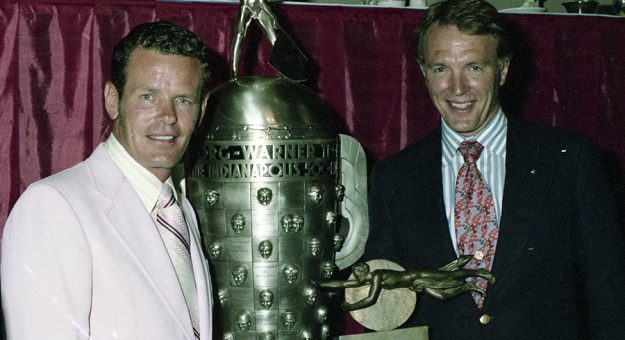INDIANAPOLIS — For the rest of time, he will be remembered best for two things: His mastery of Indianapolis Motor Speedway and a towering confidence that showed in his driving, his walk and his talk.
But in 1963, when he first found out he’d be racing at Indy, Bobby Unser was gripped by self-doubt.
Unser, who died this past May at his Albuquerque home, had spent the late 1950s and early ’60s banging around dirt tracks “in New Mexico, Arizona, California, all over the Southwest.” Indianapolis was a dream, as it was for every kid who considered himself a racer. But it was a distant dream.
“I didn’t think I was going to get here,” he told me one day, in his motorhome in the speedway infield. “Didn’t know if I was good enough.”
But at the Pikes Peak Hill Climb in 1962, Unser encountered Parnelli Jones, who had gained a national reputation as a guy who could sit in anything and win. Unser was among those bowled over by Jones: “Parnelli was the golden-haired boy, the biggest thing in racing at that time.”
It turned out that Jones was something of a Bobby Unser fan, having watched him in midgets and sprint cars. They became, said Unser, “instant friends. Parnelli saw something in me. He told me, ‘It’s time for you to come to Indianapolis.’”
After Pikes Peak, they went their separate ways. Unser, back to the bullrings, put all that Indy talk out of his head.
“And then the phone rang,” Bobby grinned.
This was early in 1963. The caller was Parnelli, who announced, “I’ve got you a car to take your rookie test in.”
So now it was real. His new best friend had everything in place. Bobby Unser was going to Indianapolis.
As things unfolded, the rookie test was not his first obstacle. He had to be approved just to take the test. But Harlan Fengler, the speedway’s authoritarian chief steward, didn’t think Unser’s accomplishments warranted an Indianapolis opportunity.
“Fengler didn’t like me,” Unser recalled. “I don’t know why, other than that Fengler was a grouchy old man.”
Hardly a scenario to calm the nerves of an apprehensive newcomer. Enter Jones again.
Unser: “Parnelli had heard about all this — I may have told him myself — and he was not happy about it.”
Jones had not yet won the Indy 500. In fact, he’d only run the race twice. But “the golden-haired boy” already had serious clout, and he would use it for a friend in need. Late one evening, in Gasoline Alley, Parnelli chaired an impromptu meeting.
According to Unser, Jones said to Fengler, “I hear you’re going to turn Bobby down.”
“Yes,” said Fengler. “He needs to go back home and get more experience.”
Fifty years later, Unser still found it hard to believe what happened next. “Parnelli pokes Harlan Fengler in the chest. He says, ‘Bobby will take his test! He’s good enough to do this. He’s earned it. And you’re going to approve it.’ And Fengler stood there and took this.”
The result? “Fengler immediately approved me.”
Unser breezed through the rookie test — “truly, it wasn’t hard” — in an Epperly roadster owned by John Chalik. Then came practice and a search for the speed it would take to qualify. In Chalik’s car, Unser was nowhere close.
Even in 1963, new tires were a great way to lower lap times. But Chalik, perhaps thinking he’d only be throwing good money after bad, told Unser, “No more tires. The ones you’ve got are the ones you’ll have to qualify on.”
Once again, Jones showed up when he was needed.
“Parnelli looked at my chief mechanic,” Unser recalled, “and said, ‘Bobby just quit.’”
Then Jones marched Unser up pit road, to where Andy Granatelli was sitting beside one of the three Novi-powered Kurtis roadsters he had entered. This one, a yellow No. 6, had no assigned driver.
Jones said, “Andy, this is Bobby Unser. Why don’t you let him take your car out?”
Here came another test of morale. Unser: “The Novi was more powerful than anything around at the time. Granatelli looked at me and said, ‘What makes you think you can drive the Novi?’ I didn’t really have an answer.”
Something — Unser figures it was Parnelli’s endorsement — made Granatelli say, “Go get your uniform.”
The Chalik roadster, on its old tires, had struggled to lap at 144 mph. Aboard Granatelli’s car, Unser topped 147 after just three laps. With sudden speed came sudden glory.
“Instantly, I’m a famous race driver,” said Unser. “I’m the new kid going fast in the famous Novi.
“My reputation, my whole life, had changed in one hour.”
He qualified easily, with a four-lap run of 149.421 mph. Only 11 cars went quicker. And he never doubted himself again. Why would he? He had displayed his mettle on the only track that ever worried him.
In time he got faster, smarter and became, in his estimation, “a hard, blood-and-guts, win-at-any-cost race driver.”
He conquered Indianapolis in 1968, 1975 and 1981, and every May he strode through Gasoline Alley like it belonged to him.
His obituary said he was 87. Nonsense. From 1963 until he left us, Bobby Unser was pure 500.
